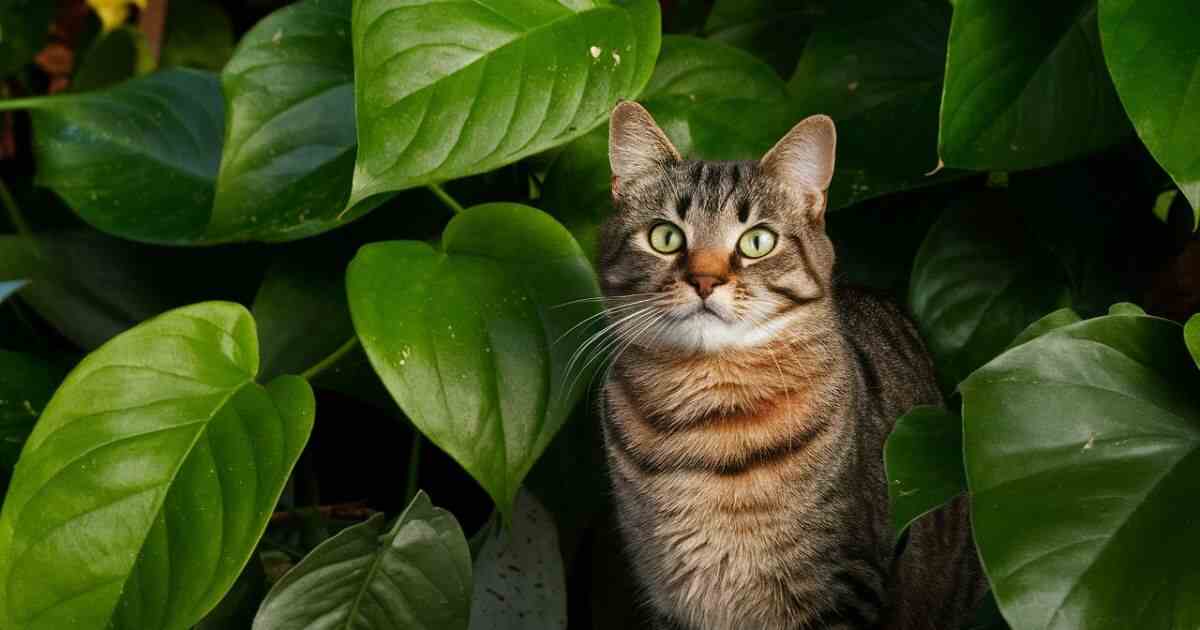Pothos, also known as Devil’s Ivy or Golden Pothos, is a popular houseplant because it’s good to care for, has lush leaves, and helps clean the air. But if you have cats, you should know that pothos is toxic to them.
Pothos contains calcium oxalate crystals, which can irritate your cat’s mouth, throat, and stomach if they eat it. It’s usually not deadly, but it can cause your cat some discomfort.

Understanding the Problem: Calcium Oxalate Crystals
The tiny, needle-shaped crystals in pothos are what make it toxic to cats. When your cat chews on a pothole leaf, these crystals can irritate their mouth and digestive system. This irritation can cause various unpleasant symptoms, which we’ll discuss next.
Signs and Symptoms of Pothos Poisoning in Cats
If you think your cat might have eaten pothos, watch for these signs:
- Oral Irritation: Excessive drooling, pawing at their mouth, or trouble swallowing can mean their mouth is irritated.
- Vomiting: Cats often vomit because of the irritation from the calcium oxalate crystals.
- Diarrhea: Diarrhea can happen as your cat’s digestive system tries to get rid of the irritating plant material.
- Loss of Appetite: The discomfort from the potholes might make your cat less interested in eating.
Severity of Pothos Poisoning
Luckily, pothos poisoning is usually not life-threatening for cats. However, how serious the symptoms are can depend on how much of the plant your cat ate. If you think your cat has eaten a lot of pothos or if their symptoms are severe, you should contact your vet right away.
Protecting Your Curious Cat (and Your Precious Pothos)
Here are some tips to keep your cat safe and your pothos healthy:
- Provide Alternatives: Give your cat plenty of toys and scratching posts to keep them away from the pothos. Cat grass is also a good option because it’s safe for chewing.
- Place Strategically: Put your pothos plants in high places or on shelves that your cat can’t reach.
- Use Bitter Apple Spray: Spraying a bitter apple solution on the pothos can help stop your cat from chewing on it. Just test the spray on a small part of the plant first to make sure it doesn’t harm it.
- Supervise: If you can’t fully keep your cat away from the pothos, watch them when they’re in the same room as the plant.
My cat ate pothos but seems fine
Even if your cat doesn’t show any symptoms after eating a small amount of pothos, it’s still a good idea to be cautious. Watch for signs like vomiting, diarrhea, or loss of appetite. If you see any of these symptoms or are worried about how much pothos your cat ate, contact your vet. They can give you the good advice to keep your cat healthy.
Cat safe plants
Add some cat-safe plants to your home! Spider plants, ponytail palms, bromeliads, and air plants are all safe for curious cats. They come in different shapes and colors and help clean the air, making your home a lively and cat-friendly space. Just remember, even safe plants can be a choking hazard if pieces break off, so keep an eye on your cat around any plants.
Considering Cat-Safe Alternatives
If you love the look of pothos but worry about your cat’s safety, there are many safe plant options. Some good choices are spider plants, ponytail palms, and air plants.
By knowing the risks and taking some steps to prevent problems, you can make sure both your pothos and your cat stay happy and healthy in your home. With a bit of planning, you can create a safe and enjoyable space for both your furry friend and your plants.